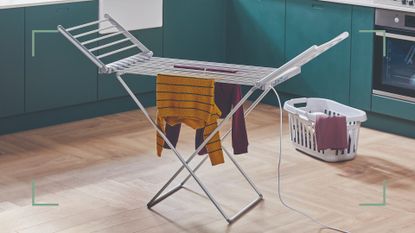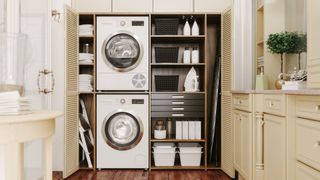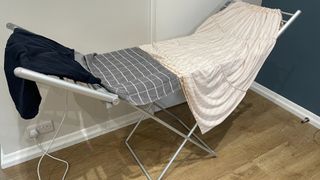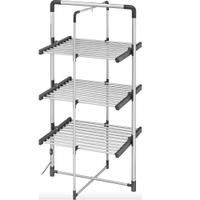How much does a heated clothes airer cost to run? Is it cheaper than turning up the heating?
Heated clothes airers are an efficient way to dry your laundry, especially in winter – but how much money do they cost you per hour?

Heated clothing airers can prove to be incredibly useful during the winter months, providing us with a speedier way to dry our clothes when ordinary airers just won’t cut it. But just how much does a heated clothes airer cost to run?
Are heated clothes airers actually a more cost-efficient way of drying clothes indoors; or are you better off using an ordinary airer and cranking the heating up, or even using your tumble dryer?
The best heated clothes airers work quickly and efficiently to dry your clothes using either heated rails or hot air ventilation. For many people, this is far preferable to leaving your clothes to dry on a regular airer – a process which can often take a whole day, if not days in the cold weather, particularly if you live in a poorly ventilated property.
Heated airers, on the other hand, should dry at least the majority of your clothes in just a couple of hours, if not less. In this sense, heated airers are far superior to non-heated airers – but what about the cost of running them? Are they expensive to use, given that they use electricity? And how do they actually stack up – price-wise when compared to other drying methods, such as a tumble dryer?
Here experts reveal how much yours should cost to run...
How much does it cost to run a heated clothes airer?
Using a heated clothes airer is inevitably going to be pricier than a non-heated airer (which clearly costs nothing bar the original purchase price), but are heated clothes airers expensive to run?
Energy expert, Dan Moore at PriceYourJob explains that running costs will vary depending on the airer you have. "There are many different models of heated clothes airers on the market, so the cost to run yours will depend on its power, as well as its size. Some also come with covers to encapsulate the clothes, which reduces the drying time, and so the cost to run it."
Sign up for the woman&home newsletter
Sign up to our free daily email for the latest royal and entertainment news, interesting opinion, expert advice on styling and beauty trends, and no-nonsense guides to the health and wellness questions you want answered.
But before diving into the cost of running a heated clothes airer, it’s also important to consider the upfront cost. While there are lots of smaller, affordable options which start from around £40, some more premium and larger models can cost up to £200, which is something to bear in mind.
How much does a heated clothes airer cost to run, then? In general, they are a fairly inexpensive appliance to use, and yours shouldn’t cost you too much more, on average, than £1 for a full drying session. However, this number will decrease significantly if you have a cheaper model, such as this 220W Portable Heated Clothes Airer from Robert Dyas.
To calculate the cost of using your heated airer, or perhaps the heated airer you’re looking to invest in, energy expert William Hobbs, at MyJobQuote, explained that you need to take a look at the power rating of your specific model.
"Look for the power rating of your heated clothes airer; you should be able to find this in the manual or on the manufacturers' website," he says. "If the power rating is in Watts, you’ll need to convert it to kW, and you can do this by dividing the number by 1,000." Take this Dry:Soon Deluxe 3-Tier Heated Airer from Lakeland, for example; its power rating is 300W, meaning the number you should be left with is 0.3.

Then, William explains, you’ll need to use this number in a small, simple calculation (don’t be scared!) to work out how much it should cost to use. To do this, you’ll need to consider how long you generally tend to use your airer; be it two hours at a time, or six hours in order to dry your clothing in its entirety.
"Multiply the kW number by the time in hours you use the airer, and then multiply this by your electricity tariff. If you don’t know your electricity tariff, it should be no more than 27p, as this is the current capped price," he explains.
"So, your calculation should be kW x hours x your tariff in pence (0.27, for example). This is the total cost in pence to run your heated clothes airer."
What would this calculation look like if, for example, it was completed using the Lakeland heated airer, for a full six hours of use? In that case, the equation would be 0.3 x 6 x 0.27. This equals around 48p in total, meaning the Lakeland model will cost almost 50p to get most of your laundry dry.

William Hobbs is an expert in sustainability and energy. Having previously worked as an electrician, William has expertise in the electric field. In recent years, William has moved on to sustainability and energy consultancy as well as providing his advice and expertise for MyJobQuote. Over the years, William's expert tips and comments have been featured in a range of leading press outlets.
Sharing another example, Dan says, "If a 220W heated clothes airer takes 8 hours to fully dry your laundry, and the current cost of electricity is 27 pence per kWh (kilowatt-hour), the equation is done as follows: 220 divided by 1000 (to get the number of kilowatts) = 0.22 x 8 (hours) x 0.27 (pence per kilowatt-hour) = 47p. So a 220W heated clothes airer will cost 47 pence to run for 8 hours."
Heated clothes airers, as such, are arguably one of the most cost-effective ways to dry your clothes, and shouldn’t set you back too much financially, even when left on for hours.
And if you're looking to make them even more economically sensible, using one of the best dehumidifiers in tandem will also help to reduce their running cost, as it will simultaneously because dehumidifiers are good for drying clothes by helping to remove excess moisture. Factor in how much it costs to run a dehumidifier to calculate the overall costs.
BLACK+DECKER 3-Tier Heated Clothes Airer Aluminium | was £155 now £109.99
This generous heated clothes airer offers plenty of hanging space to effortlessly dry a full laundry load. The experts say this "3-Tier Airer costs an average of just 8.4p per hour, meaning that a single tumble dryer cycle costs roughly the same as 18 hours of using this airer. saving you significantly more money and energy." Available at Amazon
FAQ
Do heated airers use a lot of electricity?
Given how little they cost to use, heated clothes airers certainly aren’t a big electricity drain, though it does depend on the model you have.
"Heated clothes airers are generally designed to be energy efficient," Jon Bonnar, managing director at Cotswold Energy Group (CEG) says. "Although the amount of electricity used does depend on a model’s wattage and the duration of its operation; compared to some other appliances, such as tumble dryers and radiators, heated clothes airers tend to use much less electricity."
Dan reiterates that some models do use less electricity than others. "The smaller the airer, and the lower the wattage, the less electricity they will use," he explains.
So if excessive electricity usage is a concern for you, it might be helpful to consider using a smaller clothes airer with a lower wattage. However, there are drawbacks to this that you may want to consider. Dan points out, "Bear in mind that lower wattage and less drying space means you cannot dry as much laundry, and it will take longer than a larger more powerful heated clothes airer."
With this in mind, it may be wise to consider whether a larger airer does indeed make sense for your home and family life, especially if there are lots of you living in your household. Although a bigger model will technically use more electricity on a per-hour basis, it should dry your laundry faster and more thoroughly, which in turn will allow you to have it on for less time.
Are heated airers cheaper to run than tumble dryers?

There's almost no question about which of these appliances is more affordable, according to Dan. "Tumble dryers are one of the most energy-intensive and therefore expensive electrical household appliances to run, so it is undeniably cheaper to use a heated clothes airer," he says.
However, it’s worth remembering that tumble dryers will typically dry your clothes much faster than a heated clothes airer, so the right choice for you and your home might depend on how quickly you need to get through your laundry load.
"Heated clothes airers typically take around four hours to dry lighter items of clothing such as T-shirts, and up to ten hours to dry jeans and thick jumpers,” William says. “This means you could pay between 32p and 81p to get your laundry dry if the airer is on the entire time."
A tumble dryer on the other hand will be quicker, but pricier. "A typical tumble dryer cycle costs from 80p to dry small items if your machine is fairly energy efficient, and could take just one hour. But for longer cycles (around 2 hours) at warmer temperatures the cost is likely to be around £1.80," William explains.
Evidently, a heated clothes airer is much cheaper to use than a tumble dryer, even when in use for an entire day. However, if you're happy and able to pay the extra, you may consider the extra cost of a tumble dryer cycle to be worth it, as there's no doubt that this appliance can dry your items in practically half the time.
Are heated airers cheaper than radiators?
You might feel compelled to hang your wet washing on your radiators in order to get your clothes dry – after all, it’s a win-win, right? Your clothes will dry, and you can keep your house nice and warm, too. Unfortunately, it’s not all that simple.
In fact, drying your clothes on radiators might not actually be that great an idea. "Radiators aren’t really designed to dry clothes," William explains. "As heat rises it pushes the moisture from your clothes upwards, where it’s likely to cling to cold surfaces such as windows and exterior walls. This causes condensation and dampness." The last you want is to then deal with cleaning mould off walls as a result of drying clothes.
And that’s not all. Dan says, "Drying clothes directly on radiators is also not energy efficient. The damp clothes restrict the heat being emitted into the room making the boiler work harder to heat the space too."

If you do want to use the heat from your radiators to dry clothes, it’s better instead to simply have your clothes drying in a room where your central heating is on, William suggests. "If you’re using central heating to dry your clothes, it’s best to hang your clothes on a standard airer rather than directly on your radiator, as you will otherwise block the heat."
When drying indoors consider trying the expert recommended plants that help with condensation by removing excess moisture, in the same way that dehumidifiers work.
But which option is cheaper – drying your clothes via your central heating and radiators, or on heated clothes airers? Once again, it appears that heated clothes airers win out, both in terms of affordability, and when it comes to drying your clothes safely and effectively.
"If you’re putting the heating on purely to dry your clothes, this could be costing you £1.68 per hour, as gas boilers typically use 24kW of power to run up to ten radiators, as an example," William says. And, as we know, heated clothes airers on the other hand can be as affordable as just 7-10p an hour to run – so there’s a clear winner in this debate.

Are heated airers a good idea?
If you’re debating using a heated clothes airer for your laundry-drying needs, the experts tend to agree that it can be a fantastic purchase if you struggle to get your items dry, especially in the winter – and particularly if you live in a damp or poorly ventilated property.
Not only are they a much more affordable alternative to drying your clothes in a tumble dryer, but they'll also certainly get your washing dry much faster than if you used a non-heated clothes airer. They can also be relatively inexpensive to buy, and will prevent your clothes from getting that damp smell, as they'll dry that much quicker.
However, there are a few things you need to bear in mind to ensure your heated clothes airer runs in the most effective way.
"You do need to rotate clothes on heated airers, to ensure they dry evenly," William says. "You should also make sure there’s a good flow of air in your home when drying clothes indoors to prevent damp and mould. Opening windows or vents will ensure you’re not trapping excess moisture inside your home, and will prevent condensation on windows, for example."
You should also make sure that you are buying an airer that is large enough for your household laundry load; it won’t be very useful to buy one that holds just a couple of t-shirts and some underwear if you have a family of five at home.
Similarly, Dan also notes that to make them as effective as possible, it’s well worth looking out for an airer with one particular accessory. "Typically, a heated clothes airer with a cover will dry wet laundry much faster than one without a cover," he explains.
Amy Hunt is an experienced digital journalist specialising in homes, interiors and hobbies. She began her career working as the features assistant at woman&home magazine, before moving over to the digital side of the brand where she eventually became the Lifestyle Editor up until January 2022. Amy won the Digital Journalist of the Year award at the AOP Awards in 2019 for her work on womanandhome.com.
-
 Ageing expert reveals 4 tips to 'build better bone' on Davina McCall's new podcast - and why it's so important
Ageing expert reveals 4 tips to 'build better bone' on Davina McCall's new podcast - and why it's so importantDr Vonda Wright is a leading surgeon, scientist, and researcher on longevity and mobility
By Grace Walsh Published
-
 Zara Tindall’s olive green Christmas coat proves why we should never underestimate the style power of outerwear
Zara Tindall’s olive green Christmas coat proves why we should never underestimate the style power of outerwearZara Tindall's 2023 Christmas Day outfit was unbelievably elegant and it reminded us how key coats are to winter styling
By Emma Shacklock Published
